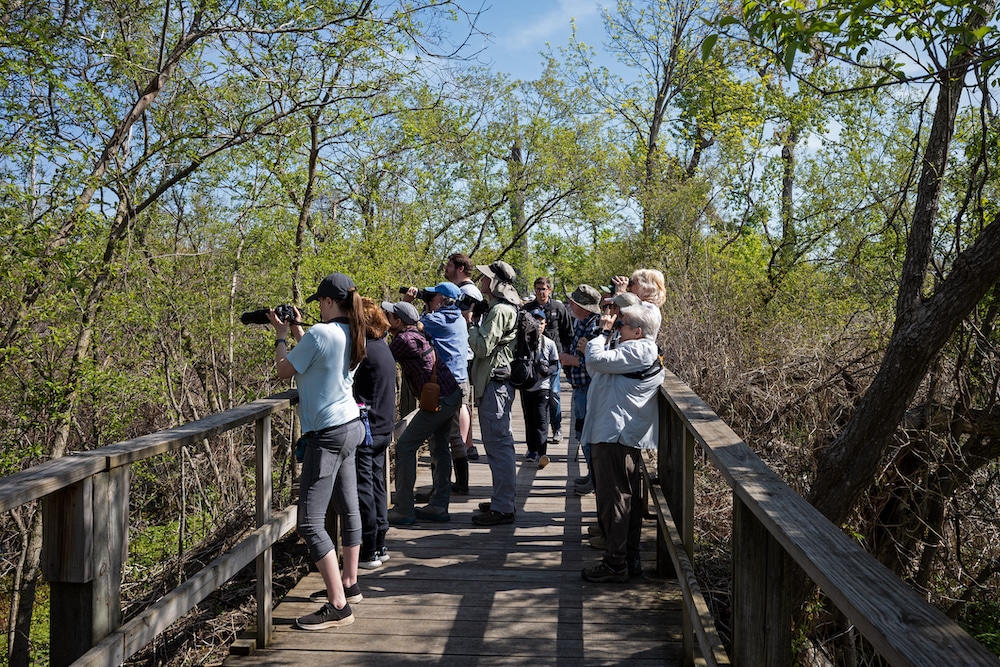
Quick Key Facts
- More than 45 million people bird in the U.S., spending around $41 billion a year on their hobby.
- U.S. ornithologist Florence Merriam Bailey published what is largely considered the first modern bird guide in 1889 titled Birds: Through an Opera-Glass.
- Twitching is a type of birding in which participants travel far and wide to see rare species.
- One study found that increasing the number of bird species in a person’s daily life by 10 percent raised their contentment more than increasing their income by 10 percent.
- People who engage in wildlife-based recreation like birding are four to five times more likely to actively promote conservation.
- Bird data posted specifically on eBird now varies from official scientific surveys by only 0.4 percent per year.
- The American Birding Association has crafted a “code of birding ethics” that has three main sections: 1. “Respect and promote birds and their environment;” 2. “Respect and promote the birding community and its individual members;” and 3. “Respect and promote the law and the rights of others.”
- Hummingbirds must drink nectar every 10 to 15 minutes from 1,000 to 2,000 flowers per day.
- One 2013 study found that domestic cats kill 1.3 to four billion birds in the U.S. every year. This makes them likely the leading human-related killer of birds in the country.
- In North America alone. bird populations have declined by 29 percent, or nearly three billion birds, since 1970.
What Is ‘Birding’?

McKinneMike / iStock Editorial / Getty Images Plus
Birding is the act of observing and identifying birds in the wild as a form of recreation. This can range from taking note of all the birds who visit a backyard feeder, or traveling across the country to try to see more U.S. bird species than anyone else in a 12-month period, like the characters played by Jack Black, Owen Wilson and Steve Martin do in The Big Year. Birding is a popular pastime: More than 45 million people bird in the U.S., and they spend around $41 billion a year on equipment like binoculars or trips to see birds. In the UK, more people belong to the Royal Society for the Protection of Birds than all of the country’s political parties put together. While it’s historically been associated with older, wealthier, whiter adults, visible interest in the activity is widening alongside awareness of its many benefits for both birders and birds.
In the past, bird lovers would differentiate between birdwatching and birding, with birdwatching seen as a more amateur and passive observation of birds and birding — defined in this case as going out and tracking down different species — as more serious and active. But in recent years there has been a push to make the community more inclusive by leveling the hierarchy and applying the term “birder” to everyone, since it includes people who perceive birds through senses other than their eyes. Birdability coordinator Freya McGregor has proposed a new definition of birding: Simply, “The act of enjoying wild birds.”
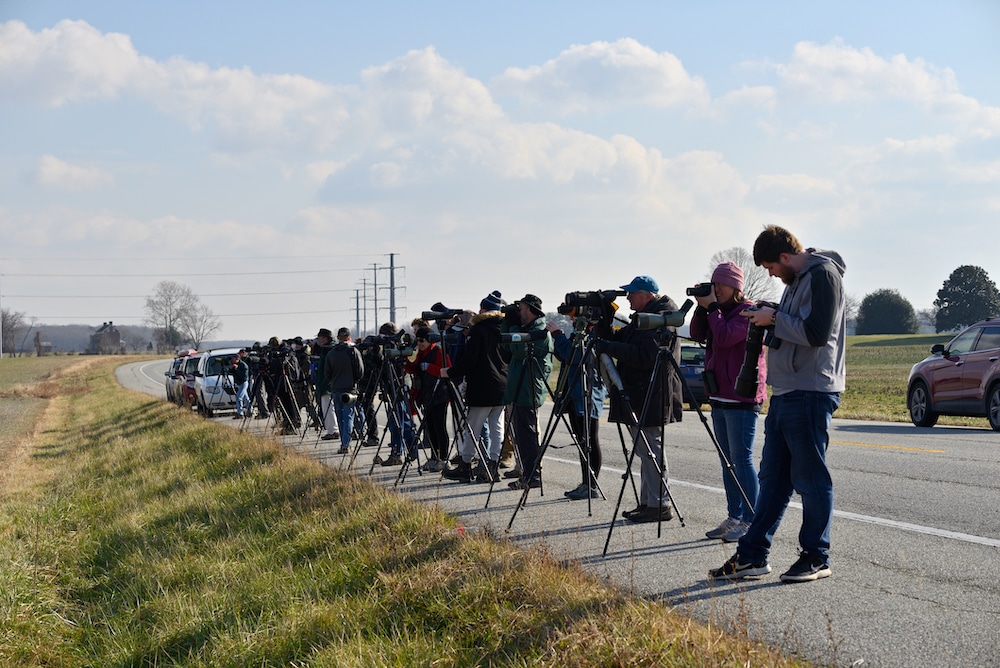
A Brief History of Birding
Humans have probably been observing birds since the beginning of our history as a species. One of the images painted on the walls of the Lascaux Cave in France in 15,000 to 10,000 B.C. was a man with the head of a bird, and some prehistoric artists painted owls in other French caves. However, the hobby we recognize today as “birdwatching” or “birding” evolved over the course of the 19th and 20th centuries.

Birding developed as an alternative to the 19th-century trend of collecting stuffed bird specimens for display or scientific study, as Tim Birkhead details in Birds and Us: A 12,000-Year History From Cave Art to Conservation. One early birder, British ornithologist Edmund Selous, converted from stuffing to watching while observing two European nightjars in 1898. “Now that I have watched birds closely, the killing of them seems to me as something monstrous and horrible,” he wrote. In 1901, he published a book called Bird Watching, which is believed to be the first use of that term. Another early proponent of observing over killing was U.S. ornithologist Florence Merriam Bailey, who published what is largely considered the first modern bird guide in 1889 titled Birds: Through an Opera-Glass, which is still in print! She was also distressed by the killing of birds to decorate hats with their plumage and recommended birdwatching as an antidote: “We’ll take the girls afield, and let them get acquainted with the birds,” she said. “Then of inborn necessity, they will wear feathers never more.”
Selous’ and Bailey’s models of compassionate and curious avian engagement took off on both sides of the Atlantic by the early 1900s, aided by improvements to the design of binoculars over the latter half of the 19th century. Birding saw a boost of popularity during and after World War II as well, driven in part by the publication of more field guides, including James Fisher’s Watching Birds, which sold more than a million copies. The hobby’s popularity continued to soar through the 50s, 60s, 70s, and 80s through to today. Improvements in spotting technology and access to the internet have made it easier to identify birds and share that information with others. Guides have become more extensive, and more birders sharing more information means that people are actually seeing more birds now despite some decreases in populations.
The expansion of air travel and communication technology in the second half of the 20th century has made it easier for people to travel far and wide in search of rare birds. This type of birding has earned its own name: twitching. The term comes from British birder Howard Medhurst, who used to ride on the back of a friend’s motorcycle when their group went to spot birds in the 1950s. When the group reached their destination, he would dismount jerkily and shiver, or twitch, while lighting a cigarette. The rest of the group began to copy his movements and to refer to rare-bird chasing as “to go on a twitch.” Twitchers will often attempt Big Years, in which they try to spot as many different species as they can in a certain area. One innovator of the practice was U.S. businessman Guy Emerson, who spotted 497 species while traveling in North America in 1939. The current international record holder is Arjan Dwarshuis of the Netherlands, who logged 6,852 species in 2016 by traveling to 40 countries on every continent except Antarctica.

In the past several decades, birding has also gotten more diverse. When it first emerged, birdwatching was considered a hobby for the wealthy, especially men. But, as society changed over the 20th century, birding did too, with more women, minorities, and people of all economic classes getting involved. Black Birders Week was launched in 2020 to draw attention to African American bird lovers, and, as of 2023, the leaders of the National Audubon Society and the American Ornithological Society are both women. Molly Adams founded the Feminist Bird Club in 2016 to make birding and the outdoors more accessible to people who might not feel safe accessing it alone and to promote positive change. However, while birding has become more visibly diverse and inclusive in the last decades, if you take McGregor’s definition of “the act of enjoying wild birds,” it’s more likely than not that people of all genders, races, classes, nationalities and identities have been birding under the radar from the beginning. For example, in the early 1800s, rural working class poet John Clare penned detailed descriptions of the nests and habits of birds in the English fenlands based on careful observation. Clare is one of the rare working-class voices to enter the cannon relatively early, but doubtless there were many others whose observations stayed between them and the birds.
What Are the Benefits of Birding?
Birding has many benefits both for the people who do it and what they watch.
Mental and Physical Health
A growing body of research has shown that spending time in nature is good for your mental and physical health, and there is evidence that spending that time birding can be especially healing. One 2022 study found that hearing or seeing birds could boost mood for up to eight hours, both among healthy individuals and individuals with depression. The study controlled for seeing or hearing other natural elements like trees, plants or water and found that noticing birds still made a difference. Another, from 2013, found that participants associated birdsong more than any other natural sound with stress relief and improved attention span. A third, from 2021, found that living near more species of birds was correlated with increased happiness: Upping the number of species by 10 percent raised people’s contentment more than increasing their income by 10 percent. Birding is also good for physical health by encouraging people to spend more time outdoors and to walk or hike to better birding spots. The Royal Society for the Protection of Birds has even teamed up with doctors in Shetland to prescribe outdoor activities, including birdwatching.
Community

Another way that birding can boost your mental health and overall well-being is by introducing you to a larger community that shares your interest. Most local wildlife refuges or parks, local bird groups, or local chapters of national bird groups will host outings that anyone can join and learn how to spot birds in that area. If you prefer to bird alone, you can also interact with other birders through social media or digital platforms like eBird, where you can both log your own sightings and read what birds others have spotted in your area.
Conservation
From its origins as an alternative to specimen collections and a lure away from feathered hats, birdwatching has been closely linked with bird conservation. A 2015 study found that people who engage in wildlife-based recreation activities — including birdwatching — were four to five times more likely to actively participate in conservation activities like donating money, joining environmental groups, working to restore habitat on public lands and lobbying for more wildlife recreation. The three major birding organizations in the U.S. — The National Audubon Society, the American Birding Association (ABA) and the American Ornithological Society — consider conservation a key part of their work and missions. It turns out Bailey was right: When people begin to pay attention to birds, they often become more motivated to protect them and their habitats.
Citizen Science
One important way that birders aid conservation efforts is by providing more information to scientists about birds and their numbers and habits. Determining population trends is essential for conservation, and bird data posted on eBird specifically now varies from official scientific surveys by only 0.4 percent per year. Birders also engage in annual surveys of bird numbers to aid in research. One example is the National Audubon Society’s Christmas Bird Count. This was started by ornithologist Frank M. Chapman on Christmas Day, 1900, as an alternative to the tradition of hunting birds during the holidays. Now, tens of thousands of citizen scientists participate between December 14 and January 5 every year, and the data helps conservationists track the health of bird populations and determine priorities. Other annual surveys include The Big Sit and the Great Backyard Bird Count.
Are There Any Downsides to Birding?
While birding can have many positives for nature and humans, like any activity, it has drawbacks when participants choose to be less than respectful of nature and other humans. None of these problems are necessarily inherent to the act of looking at birds; they are rather things that birders should be mindful to avoid.
Damaging Species and Ecosystems
While birding has many conservation benefits, it can also harm birds and their habitat if done improperly. For example, some birders will play a recording of a bird they are seeking in order to encourage a response in the wild. This practice has been shown to increase the time some birds spend singing, which could harm them by using up energy and distracting them from other activities. In the age of social media, postings of rare or vulnerable birds can draw large crowds that could disturb or harm them. To address situations like these, ABA has crafted a “code of birding ethics” that has three main sections: 1. “Respect and promote birds and their environment;” 2. “Respect and promote the birding community and its individual members;” and 3. “Respect and promote the law and the rights of others.” Section 1 includes minimizing playback, being careful around nests and roosts and reducing habitat disturbance by sticking to paths and trails.
Taking It Too Far
Birding can turn competitive or obsessive, especially among people who attempt Big Years or travel in search of rare birds. People have missed important family events and put serious relationships in jeopardy. As sites like eBird have made it easier to share information, they have also increased the competitiveness, and sometimes people can be rude to birders who, for example, misidentify a bird in a public forum. The ABA code of ethics applies here too, encouraging birders to “respect the interests, rights, and skill levels of fellow birders” and be welcoming to newcomers.
Environmental Injustice
Birding has historically been seen as a hobby for white and well-off people. Sometimes, people of color can even be harassed when they attempt to spend time in nature, such as the infamous incident in 2020 when a woman called the cops on African American birder Christian Cooper when he asked her to leash her dog in a leash-only area of Central Park. For lower-income people, both purchasing binoculars and finding leisure time can be barriers to birding. There is also a legacy of colonialism and racism in early ornithology. John James Audubon — a prominent 19th century bird artist and scientist who gave the National Audubon Society its name — also owned slaves and embraced scientific racism. In recent years, the birding world has made efforts to reconcile with this history and make the hobby more inclusive. The National Audubon Society considered changing its name, but ultimately decided against it. However, local chapters have abandoned the Audubon name. The American Ornithological Society announced in 2023 that it would change all the English names of birds in its jurisdiction named after people, since many of them were named after controversial figures who had a history of racism. “Everyone who loves and cares about birds should be able to enjoy and study them freely — and birds need our help now more than ever,” AOS President Colleen Handel said of the change.
How to Get Started
If you are interested in birding, there are many resources available to help you get started.
Where to Find Birds

You can find birds everywhere, but the best place to start is somewhere near home with either green space, open water or both. Some birds, like gulls, crows or mallards, make their presence obvious. For others, you might have to look a little harder. The National Audubon Society recommends taking a moment to clear your head from other distractions, looking at places where birds might perch such as power lines or trees, scanning the landscape slowly, looking with your eyes before trying binoculars, listening for distinctive bird calls and moving on once you have seen a sizable number of birds in one area.
How to Attract Birds
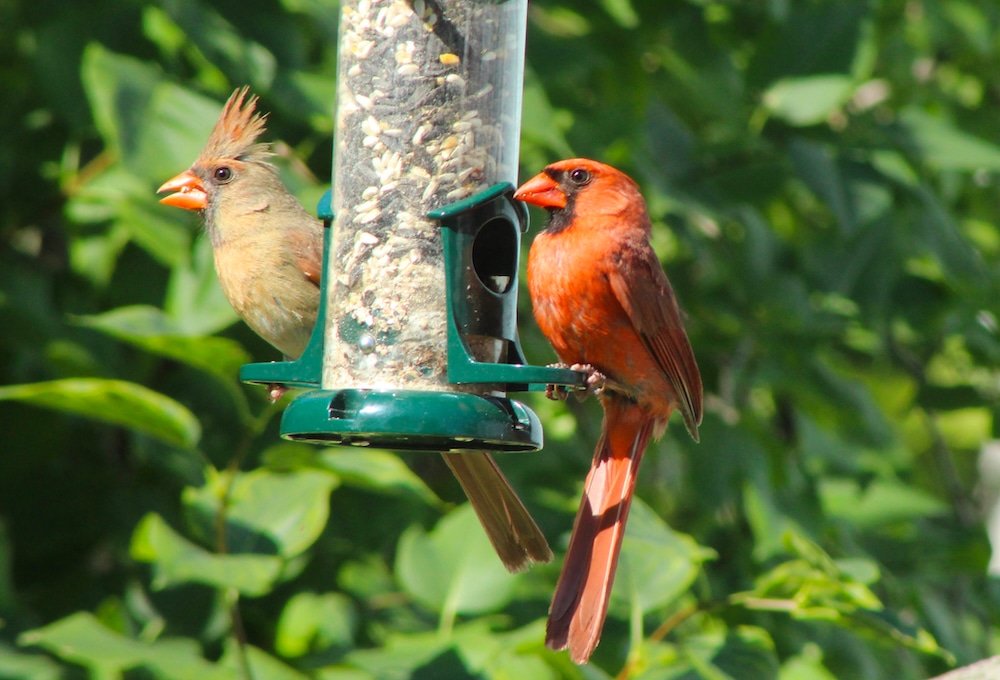
You don’t even have to leave home to bird. Backyard birding is the act of observing birds from your porch or window by enticing them to come to you. The best way to do this is by planting native plants in your yard. This will draw both birds and insects, which the birds can eat. If you decide to install feeders, smaller tubular feeders filled with thistle seed will attract finches, while a larger feeder filled with nuts, fruit and sunflower seeds will be a hit with cardinals, grackles and blue jays. Place your feeders within 12 feet of another feature the birds can fly to if predators approach. This will make them feel safer visiting your home. The most important times to feed birds are during extreme weather events, migration season and late winter or early spring. During the summer, most species can find plenty of food.
The exceptions are nectar-hungry hummingbirds. There are at least 53 species of North American birds that primarily drink nectar, including hummingbirds and orioles. Hummingbirds in particular must drink nectar every 10 to 15 minutes from 1,000 to 2,000 flowers per day. You can plant hummingbird-friendly flowers, but while you wait for them to grow, fill feeders with a mixture of one part white sugar to three parts water. It’s important to remove feeders if you learn of any avian disease outbreaks in your area that your feeders could spread.

How to Identify Birds
There are many digital and paper resources that will help you identify birds. The Cornell Lab of Ornithology’s Merlin app will give you an ID based on a photograph or audio recording of their song. There are also many field guides to birds in your area. Popular books for U.S. birders include The Sibley Guide to Birds, the Peterson Field Guide to Birds of North America, the Golden Guide’s Birds of North America and National Geographic Field Guide to the Birds of North America. It’s better to choose a guide with drawings rather than photographs, as artists make sure to include all identifying features that might be obscured by lighting. When you are trying to match a wild bird to a potential ID, it’s important to consider what group it belongs to, i.e. is it a sparrow or an owl; its shape; its size; its behavior; where you are seeing it; when you are seeing it; any distinctive markings; and its song or call.
What You Need

Bird enthusiasts participate in the National Audubon Society’s 117th annual Christmas Bird Count in Anne Arundel County, Maryland on Dec. 18, 2016. Will Parson / Chesapeake Bay Program
You do need a limited amount of gear for birding — most importantly, binoculars. The National Audubon Society offers recommendations for specific models based on how much you want to spend. In general, look for a power of seven or eight and lenses on the wider end that are between 30 and 42 millimeters. In addition to binoculars and a field guide, bring whatever outdoor gear you need to safely and comfortably bird your chosen area. You may also want a notebook to compile a life list of all the different species you see. The Merlin app also allows you to keep a digital record.
How to Get Involved
Chances are, there are other birders in your area. The National Audubon Society has a guide to its local chapters here, the ABA has a list of birding clubs and organizations by state here, and the Feminist Bird Club here. Many of these local groups will advertise bird outings on their websites or social media pages in local parks that you can attend to get started or meet other birders. You can also sign up for their email listservs. Many will share opportunities to advocate for birds in your town, city or state as well.
How to Protect Birds (So You Can Keep Watching Them!)
Conservation is so important to birding that the ABA’s ethics code calls on birders to “support the conservation of birds and their habitats” and “Engage in and promote bird-friendly practices whenever possible.”
From Window Strikes
Building strikes killed an estimated median of 599 million birds in the U.S. in 2017. You can prevent birds from crashing into your own home by identifying large windows or windows near feeders and decorating them with vertical markings two inches by two inches apart. Adding screens can also be an effective deterrent. At night, bright lights during migration season can pull birds from their route and make them more likely to crash into the illuminated buildings. In addition to switching off your own lights during peak migration, you can advocate for your city or town to participate in a Lights Out initiative to reduce urban light pollution in spring or fall.
From Cats
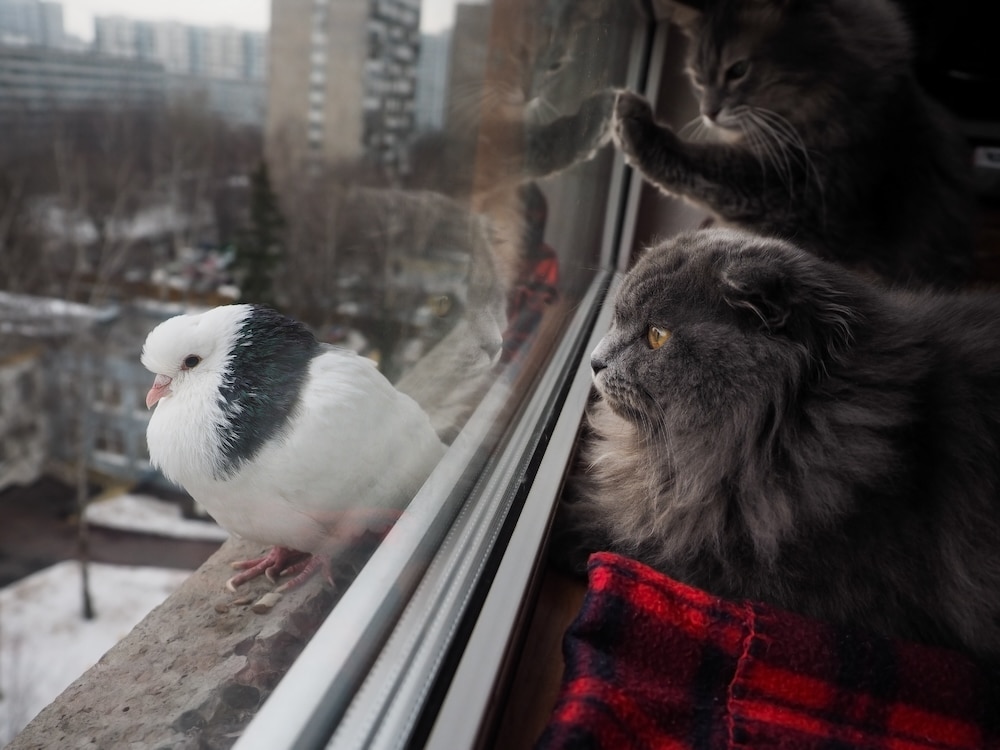
One 2013 study found that domestic cats kill 1.3 to four billion birds in the U.S. every year. This makes them likely the leading human-related killer of birds in the country. While most of these deaths are caused by feral cats, there are things pet owners can do to protect birds. The most important thing is keeping your cats indoors. If that’s not possible, make sure your yard has lots of shrubs or bushes where smaller animals can hide. Place feeders or bird baths 10 to 12 feet from where cats could hide and take down your feeders if your cat is killing birds. If you want to get a cat, adopt a shelter animal to prevent it from ending up on the streets, and never abandon cats outside.
From Pesticides
Pesticide poisoning killed a median 72 million U.S. birds in 2017. Anticoagulant rodenticides can harm or kill birds of prey when they eat rats that have ingested them. To avoid this, manage rodents in alternative ways by not leaving out food, dismantling potential nesting spots and using non-lethal trapping methods. Herbicides and insecticides, especially neonicotinoids, can also harm birds. Avoid using pesticides on your own garden, and, when possible, choose organic produce to support pesticide-free agriculture.
From Habitat Loss
While numbers are difficult to ascertain, the U.S. Fish and Wildlife Service believes that habitat loss is the leading threat to birds. Human activity clears or disturbs forests or converts wild areas to farmland or human developments. In the U.S., 4.8 million acres of wild land were converted to agriculture between 2007 and 2018. This reduces the amount of land available for winter breeding and feeding for migratory birds. You can push back against habitat loss by planting native species; creating habitats like brush piles in your yard; avoiding raking; advocating for the protection or restoration of ecosystems on a local, state and national level; and choosing brands of coffee or beef that are grown in ways that don’t harm birds.
From Climate Change
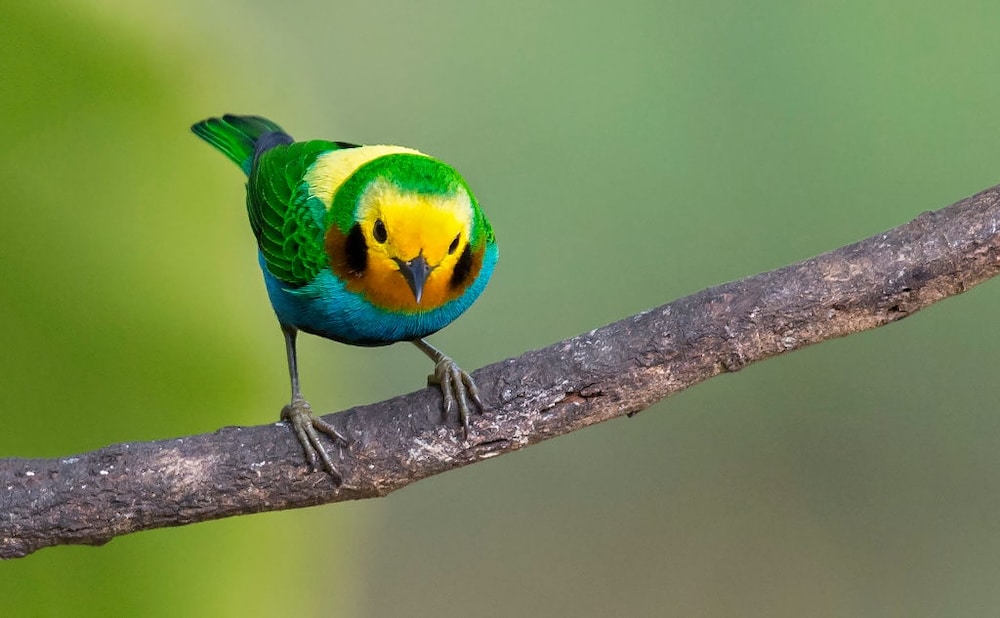
The National Audubon Society found that rising temperatures caused by the climate crisis put two-thirds of North American bird species at risk of extinction as their ranges shift due to changing conditions. However, limiting global warming to 1.5 degrees Celsius above pre-industrial levels would improve the situation of 76 percent of vulnerable species and keep almost 150 species from extinction risk. The only way this will happen is if human societies and governments swiftly phase out fossil fuels and end the destruction of natural carbon sinks like forests. You can advocate for climate action on a global, national, regional and local level and take steps to reduce your own carbon footprint by, for example, reducing car and plane travel and cutting your home’s emissions by taking steps to improve its energy efficiency.
Takeaway

In North America alone, bird populations have declined by 29 percent, or nearly three billion birds, since 1970. The biodiversity and climate crises mean that birds are perhaps more threatened than ever. Yet more and more people are learning to appreciate them. During the Covid-19 pandemic, people turned to birding as an infection-safe activity, and sales of bird seed and feeders took flight. The more people who take up birding, the more people who will grow aware of birds and the threats they face and have a strong personal motivation to protect them. So if you’re thinking of giving birding a try, go ahead and install a feeder or upload Merlin. At the least, you will make your own life more interesting. At the most, you may be inspired to help save the world.

The post Birding 101: Everything You Need to Know appeared first on EcoWatch.
